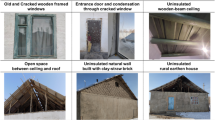Abstract
Energy use in buildings has attracted more and more attention due to its significant proportion in the energy pan of the world. China is the second largest energy user, yet the situation of energy use in the China building sector remains unclear, due to problems of statistics and data processing and problematic use of these data. In this paper, a series of methods is developed, in the first place, to give strict definitions of energy data and to divide energy use into 4 sub-sectors according to the unique situation of China. Then, each sub-sector is further analyzed through international comparisons. Existing problems of energy use and solutions for energy reduction in each sub-sector are also discussed. Accordingly, it is found that China uses much less energy, in terms of both per capita and unit area, in buildings than developed countries. The difference in energy use could be attributed, in large part, to lifestyles of local people, which could determine their way of energy use but is more determined by cultural concepts than by others such as income, technique and so on, especially in China. However, to fulfill the requirements of lifestyles with higher living standards and lower energy consumption, technological innovations are needed.
Similar content being viewed by others
References
Sartori I, Hestnes A G. Energy use in the life cycle of conventional and low-energy buildings: A review article. Energy and Building, 2007, 39(3): 249–257
Energy Information Administration. International Energy Outlook 2008. USA: EIA Publications, 2008
National Bureau of Statistics of China. China Statistical Yearbook 2009. Beijing: China Statistics Press, 2009
US Census Bureau. 2008. http://www.census.gov/popest/states/tables/NST-EST2008-01.xls
US Census Bureau. 2000. http://www.allcountries.org/uscensus/2_population.html
The Energy Data and Modeling Center. Handbook of Energy & Economic Statistics in Japan. Japan: The Energy Conservation Centre, 2008
Korea National Statistical Office. http://www.kosis.kr/eng/e_kosis.jsp?listid = B&lanType = ENG
Ministry of Commerce, Industry and Energy & Korea Energy Economics Institute. Yearbook of Energy Statistics. Seoul: Korean Energy Economics Institute, 2007
The United State Department of Energy. 2008 Buildings Energy Data Book. USA: D&R International, Ltd., 2008
National Bureau of Statistics of China. China Statistical Yearbook 2008. Beijing: China Statistics Press, 2008
Intelligent Energy of EPBD. Applying the EPBD to improve the energy performance requirements to existing buildings-ENPEREXIST. Europe: Fraunhofer Institute for Building Physics, 2007
Korean Energy Economics Institute. Energy Use Survey 2005. Seoul: Ministry of Commerce, Industry and Energy, 2005
Wang Qingyi. References for the China Sustainable Energy Program. 2007. http://www.efchina.org/FHome.do
Long Weiding. Proportion of energy consumption of building sector and target of building energy efficiency in China. China Energy, 2005, 27(10): 23–27
Building Energy Research Centre of Tsinghua University. 2009 Annual Report on China Building Energy Efficiency. Beijing: China Building Industry Press, 2009
Tu Fengxiang. Why is Chinese building energy consumption much higher than developed countries? Builders’ Monthly, 1998, (5): 58 (in Chinese)
Tu Fengxiang. How much difference of building energy consumption is there between China and developed countries. Solar Energy, 2003, (1): 11, 45 (in Chinese)
Li Baizhan, Yao Runming. Urbanisation and its impact on building energy consumption and efficiency in China. Renewable Energy, 2009, 34(9): 1994–1998
Duchin F. Technology and lifestyles: a focus for research in ecological economics. Plenary Address at the First ESEE Conference, Saint Quentin, Paris, France, 1996, 23–25
Boardman B. DECADE: Domestic Equipment and Carbon Dioxide Emissions. ECU Research Report 16. Oxford, 2007
Jeeninga H. Domestic appliances and life style. Consequences for Domestic Electricity Consumption in 2010 (Summary of Dutch Report). Petten: ECN Policy Studies, 1998
Balaras C A, Droutsa K, Argiriou A A. EPIQR surveys of apartment buildings in Europe. Energy and Building, 2000, 31(2): 111–128
Buck J, Young D. The potential for energy efficiency gains in the Canadian commercial building sector: A stochastic frontier study. Energy, 2007, 32(9): 1769–1780
Weber C, Perrels A. Modelling lifestyle e!ects on energy demand and related emissions. Energy Policy, 2000, 28(8): 549–566
Lopes L, Hokoi S, Miura H, Shuhei K. Energy efficiency and energy savings in Japanese residential buildings—Research methodology and surveyed results. Energy and Buildings, 2005, 37(7): 698–706
Natural Resources Canada. 2006 Energy Use Data Handbook. Canada: Energy Publications Office of Energy Efficiency, 2007
Yutaka T, Oki F, Yoshimitsu M, Shuichi M. A detailed energy demand estimation and CO2 emission inventory of residential house by prefecture and housing type in Japan. Journal of Environmental Engineering, 2005, 592: 89–96 (in Japanese)
Information Centre of China Meteorological Administration, Department of building science and technology of Tsinghua University. Meteorological Database For China Building Thermal Environmental Analysis. Beijing: China Building Industry Press; 2006
Earth Satellite Corporation. CME Historical Weather Data 2007. USA: http://www.cme.com/trading/dta/hist/ftp_weather.html
Liu Lanbin. Research on on-off valve regulation and household heat allocation technique in district heating system. Dissertation for the Doctoral Degree. Beijing: Tsinghua University, 2009
Building Energy Research Centre of Tsinghua University. 2008 Annual Report on China Building Energy Efficiency. Beijing: China Building Industry Press, 2008
Li Zhaojian. Study on the life cycle consumption of energy and resource of air conditioning in urban residential buildings in China. Dissertation for the Doctoral Degree. Beijing: Tsinghua University, 2007
Energy Information Administration. 2005 Residential Energy Use Survey. USA: EIA Publications, 2005
Author information
Authors and Affiliations
Corresponding author
Rights and permissions
About this article
Cite this article
Zhang, S., Yang, X., Jiang, Y. et al. Comparative analysis of energy use in China building sector: current status, existing problems and solutions. Front. Energy Power Eng. China 4, 2–21 (2010). https://doi.org/10.1007/s11708-010-0023-z
Received:
Accepted:
Published:
Issue Date:
DOI: https://doi.org/10.1007/s11708-010-0023-z




